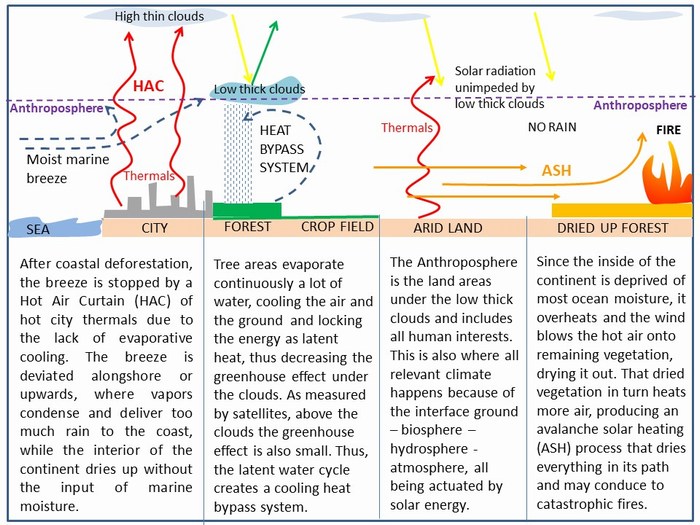The Consolidated Climate Change Theory (CCCT) –
A New Framework for Restoration
The climate system is complex, while our approach to understanding it has been fragmented, thus less successful. The CCCT is a synthesis. It provides a more complete and accurate explanation of climate change by integrating the strengths of existing theories and adding new contributions. This is a selective evolution of climate science through maturity and re-connection with millenary observations and practicality.
An Integrative View
The scientific consensus rightly connects greenhouse gases to global warming. However, a primary focus on curbing emissions has overshadowed a far older and more profound alteration to the climate system.
For millennia, humanity’s most profound alteration to the planet has been the clearing of its forests and the degradation of its lands. This has fundamentally broken the natural partnership between vegetation and the water cycle—the very system that created and stabilized Earth’s climate for life.
By integrating all significant parameters, CCCT creates a more powerful and useful framework for both understanding and solving the climate crisis.
There were previous studies and applied projects of water cycle and micro-climate restoration; CCCT builds on them and brings new insights and methods.
The Missing Links: Water Cycles and Vegetation
The CCCT integrates the critical mechanisms that have been lately downplayed as too complex to represent in current computer models and integrates them through first-principles reasoning and conceptual models, using millenary human observation as a vital validation tool alongside basic calculations.
The Dominant Role of the Water Cycle: Water evaporation is the primary cooling mechanism of Earth’s surface. Computer simulations are hampered by the insufficient theory and the rather small scale of the relevant phenomena. Conceptual simulations are for the time being more useful by relying on millenary observations and basic calculations.
The Climate-Regulating Power of Vegetation: Forests have been blamed for having a 7% smaller albedo than bare ground, despite they avoid ground overheating through their shade, they evaporate water to cool the surface by 30% and they attract and are covered for most of the time by low thick clouds that reflect solar radiation by more than 60%.
Essential Processes Described by CCCT

After traversing the atmosphere, solar radiation (SR) is partially reflected (R) by clouds and ground objects.
The rest of solar radiation is transformed into sensible heat and infrared radiation (IR) by the opaque objects.
Sensible heat produces air heating (AH), that is the global warming measured near the ground, while the infrared radiation produces the greenhouse effect with the greenhouse gasses in the entire atmosphere.
When there is water in or around objects, sensible heat transforms into latent heat, producing evaporation (E), this way decreasing the air heating (regional warming) and the infrared radiation (thus the greenhouse effect).
While the anthropogenic increase in greenhouse gasses produces about 1.5oC global warming (IPCC), water evaporation decreases the sensible heat and produces much more than 1.5oC regional cooling.
Therefore, we can compensate regionally for the emissions warming by restoring the water cycle damaged through deforestation. Planting trees or using artificial evaporative cooling where trees cannot be planted, would more than compensate regionally for the global warming, while the trees will also sequester air’s excessive CO2.
Introducing Key Mechanisms
We name the processes driving the climate crisis:
Deforestation warms the lower troposphere by about 40W/m2 (explained here) and reduces the Heat Bypass System (HBS) of the water cycle that minimizes the greenhouse effect.
Anthropogenic carbon gases warm by about 2.7W/m2 by amplifying the greenhouse effect.
Tilling for agriculture and goat keeping desolated the Anthroposphere (the lands up to 5,000 m altitude where all human interests exist). Our theory focuses on restoring the lands and climate of the Anthroposphere.
Hot Air Curtain (HAC): The barrier of rising hot air from deforested coastlines, which floods the coasts and dries continental inlands.
Avalanche Solar Heating (ASH): The self-reinforcing downwind process that propagates aridity, fires, soil erosion and desertification.

The Result: A Coherent Explanation
The CCCT explains why we see intensifying heatwaves, fires, droughts, and floods all at once—they are symptoms of a destabilized water cycle, amplified by the anthropogenic carbon gases. CCCT also introduces the powerful concept that the global climate is the result of all regional climates.
For a brief presentation of the Consolidated Climate Change Theory (CCCT): DOWNLOAD HERE
The Path Forward: Restoration, Not Just Reduction
The CCCT is a theory of hope and practical action that works with natural systems to mitigate and reverse climate change.
The solutions flowing from the CCCT—such as Avalanche Greening and Cooling (AGC), Unitary Rational Buildings (URB), and a shift to an ancestral diet—are designed to be economically beneficial. They cool the planet by repairing the water cycle, increase agricultural productivity, create sustainable settlements and larger natural reserves, and additionally improve human health.
This is not about stopping development through austerity. It’s about smarter, beneficial development that heals the planet.
[ Explore the Realistic Solutions ]